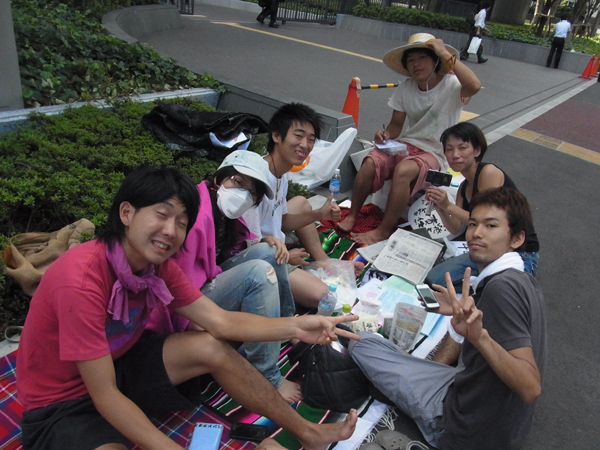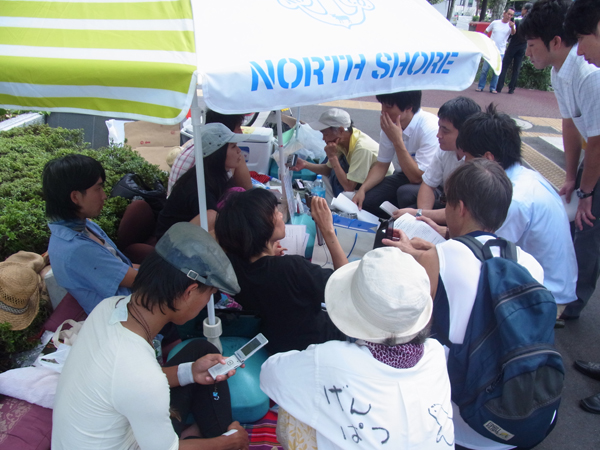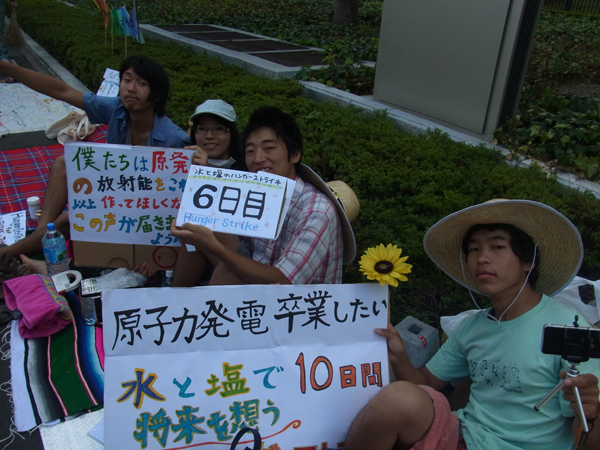Suffering in silence: Hunger strikes in Japan by a generation hungry to see an end to nuclear power
Exclusive by Gabriella White
TOKYO – Six months on, Japan, the world’s third largest economy is still recovering from the devastation of a disaster rated the worst Japan has seen since World War II. Ultimately, the very tectonics that formed these beautiful lands could ironically destroy the very archipelago they created: Japan has always been and always remain will a high-risk earthquake zone. Ongoing tremors are in fact normal and part of everyday life throughout Japan, but the country’s geographical instability and the people’s vulnerability seem to be more apparent than ever.
Tragic survivor-stories of this year’s tsunami often speak of the frightening mass of black water that rose when the tsunami wave hit on March 11th 2011, literally uprooting the land, destroying and sweeping up everything in its path. One survivor described it as resembling a “living thing rising up from the ground” like something out of a horror movie. 112,000 buildings were destroyed during that one earthquake. 20,000 people died and astoundingly a further 4000 people are still registered as missing. Much suffering still goes on as Japan’s people mourn friends and family lost to the quake and search for their loved ones, looking for clues as to their whereabouts following this monstrous disaster. There were in fact several tsunamis at work here: not just the one, stretching over 200 miles in total. The tsunamis rushed towards Japan’s coast at shocking speeds of up to 370 mph. The resort town of Minami Sanriku, famed for its oyster fishing and sea views was one of the many towns deeply impacted, affecting its population of 19,000. 95% of the town’s buildings have either been washed away or destroyed entirely. The direct impact on Japan’s capital is immediately noticeable: Tokyo is slightly dimmer than usual: Japan is in fact trying to conserve electricity and has decreased light emission to do so.
Japan’s tourism has inevitably taken a hit: people are wary of Japan’s geographical instability at the moment and as a consequence, flight prices have decreased. In a message to the world, Mr Tadatoshi Mamiya, the President of Japan’s National Tourism Organisation declares “Japan National Tourism Organization (JNTO) would like to express our sympathy and condolences to all the people who have been affected by the earthquake and tsunami that struck Japan on March 11, 2011. We would also like to express our sincere respect and gratitude to those who have been involved with the relief and recovery efforts.”
The impact on Japan’s inbound tourism has been enormous. Though only some areas of Japan (mainly the north East) have been affected, Japan’s tourism across the entire archipelago has suffered and as a result, the economy too. Mamiya further explains: “We are deeply concerned that this will not only affect Japan’s tourism industry directly, but also will have a very negative impact on our industry partners around the world.”
Heartbreakingly, the worst is not over. But by this, I am talking about something much, much worse. I do not even mean the immeasurable amount of relief work still to be done by organisations from around the world including the Red Cross, not to mention further predicted aftershocks which could rock Japan’s boat even further; rather, the consequences of the nuclear power plant explosion: this is where the real long-term danger lies.
Fukushima-Daiichi is in fact the worst nuclear power plant disaster the world has seen since Chernobyl and we all know the bodily damage and dysfunction that that caused to its victims exposed to the radiation. As government plans go ahead to build another nuclear plant, concern amongst the Japanese nation is mounting about the future dangers nuclear power could have on the country if ever a disaster like this were to occur again. Japan is geographically complex and it is a high-risk earthquake zone for good reason: Japan in fact lies on a multitude of tectonic plates, including the Pacific, Eurasian, North American, Okhotsk plates and the Honshu microplate. Noticeable effects and fear amongst residents have been heightened by the aftermath of the Fukushima plant disaster.
Going forward, governmental motivations behind the nuclear power energy policy are clear: in an already shaky global economy, nuclear power is the most economical energy source out there. It is also however, the most unsafe power option in modern society, with a life-threatening price to pay when things go wrong. 6 months after Fukushima’s power plant explosion, dangerous levels of radiation are still widespread around the Fukushima plant. Out of the country’s 54 nuclear reactors, 43 of these are now out of operation. Due to high radiation levels, all residents in a 20km radius around the plant have been evacuated for the foreseeable future. The area is eerily deserted; fields are overgrown and all vegetation poisoned. Now, youth activists in Japan are taking these concerns to the next level. A fasting group in Tokyo are demanding that Japan’s Ministry of Economy, Trade and Industry (METI) completely abolish their plans to house a new Nuclear Plant at Kaminoseki.
20-year-old Naoya Okamoto from the Yamaguchi prefecture, also known as Kin Chan amongst his peers, launched a protest on September 11th, exactly 6 months following the day the earthquake struck. In his speech, he told observers “I myself and 3 other 20-somethings are starting a hunger strike at the gate of the Ministry of Economy, Trade and Industry (METI). We will stay there for 10 days, consuming only salt and water.” Okamoto explained “In our everyday life we take things for granted, such as the air we breathe and the food we eat. They will now become a threat to our very survival, for generations to come.” Okamoto explains that the Nuclear Plants are a “negative inheritance” to future generations. “We would like to appeal these things to the society.” he says. The fasting group are also protesting against the METI’s plans to restart Nuclear Plants without proper explanation to Japan’s residents. They demand that the plan by Chugoku Electric to build a nuclear power plant in Kaminoseki-cho be cancelled.
Okamoto declares “We would also like to point out that the METI does not offer any compensation to Fukushima Citizens or any of the victims. The Government should take responsibility as they are the ones who promoted nuclear policy. We need our government to act now. Our generation appeals to everyone for support, for a society free from nuclear catastrophes.” Yesterday morning, Okamoto announced on Twitter “I’m off in a car now to the front of the Ministry of Economy, Trade and Industry. Various people came and were happy yesterday! I feel dizzy. It is the seventh day in the present days! Where will our thoughts be by the end of this protest?”
In their first exclusive interview with the British press, protesters spoke to the Culture Cave magazine to broadcast to the world their heartfelt message for the safety of Japan’s future generations. Youth activist and webhoster for the cause Yuiki Take from Kyoto University of Foreign Studies helped me communicate with protest leader Naoya Okamoto. Kin Chan is now physically weak after not having eaten for almost ten days and nights in his attempt to get the METI to change their energy policies for the better. During the interview, Okamoto explained that Japan’s citizens of today feel very much kept in the dark about government policies. Furthermore, citizens are often left feeling confused and unclear on energy plans that will directly affect citizens today and those in years to come. Protesters fasting include 22-year-old Masaaki Yamamoto from the Tokyo prefecture, 20-year-old Kanta Yonehara from the Chiba prefecture, Shiori Sekiguchi from the Tokyo prefecture and a new member, Gen Matumara from the Osaka prefecture who joined the protest over the weekend. The number of protesters continues to grow as they come to their tenth night tonight.
The youngest participant fasting is 19-year-old Shiori Sekiguchi from the Tokyo prefecture. She urges Japan’s government to find an alternative power source that does not involve nuclear power. The group want to be taken seriously and emphasise their vision for future generations. Although Shiori realistically admits that this initial strike may not get them the ultimate result of complete nuclear power abolishment, she hopes it will at least make people stop and think about Japan’s energy problem and the need for change. “I really want people to know that there is a young generation here seriously thinking about the future” Shiori explains. The group are raising awareness through a multitude of channels online too, including their website http://hungerstrike.jimdo.com/, as well as social media campaigns through Facebook and Twitter. Live updates are constantly being broadcasted by the activists on www.ustream.tv also: “It is our aim, to make people aware and if we achieve that, I think we’ll have made a difference” the University student concludes.
In recent years concerns about climate change, energy security and the increase in fossil fuel costs are spurring a revival of interest in nuclear power generation on a global scale. However, the instant destruction caused when atomic bombs were dropped on Hiroshima and Nagasaki in 1945 serve as a reminder that Japan must learn from history. Radiation released from the bombs of 1945 turned “many survivors of the initial blast into progressive invalids who suffered loss of hair, bleeding gums and debilitation until they died weeks, months, even years later,” as Life Magazine wrote.
In the UK, Aston University holds its Nuclear Energy Conference 11 – 12 October 2011 at the University’s Lakeside Centre in Birmingham. Due to this year’s Fukushima disaster, the conference is placing a heavy emphasis on discussing strategies to make nuclear power implementation safer. Then again, was it ever really a sensible idea? If you ask me, Japan’s current energy policy has kikensei[1],危険性 written all over it.
Protesters will continue to fast until their voice is heard, the nuclear power plant plans are scrapped and victims of March’s nuclear accident are fully compensated. Today Tuesday 20th September 2011 marks day 10 of the protest. It is the peaceful, but clear means of protesting through the extreme means of fasting, which is allowing Japan’s youth to voice its opinion effectively and in the most quintessential Japanese way possible: with honour.
The Culture Cave will be catching up again with the Tokyo teens and 20-somethings as the sun sets over Tokyo this evening. Our Editor will also be broadcasting in Japan next month following up these protests and efforts made by this admirable group of youths nobly campaigning for a safer, ‘nuke-free’ Japan.









An excellent piece of writing , thoughtful, and provocative.. Very well written Gabriella.. I really feel that the japanese people are so dignified..and It surely is about time that their Government behaved in a responsible and compassionate manner.
Doreen